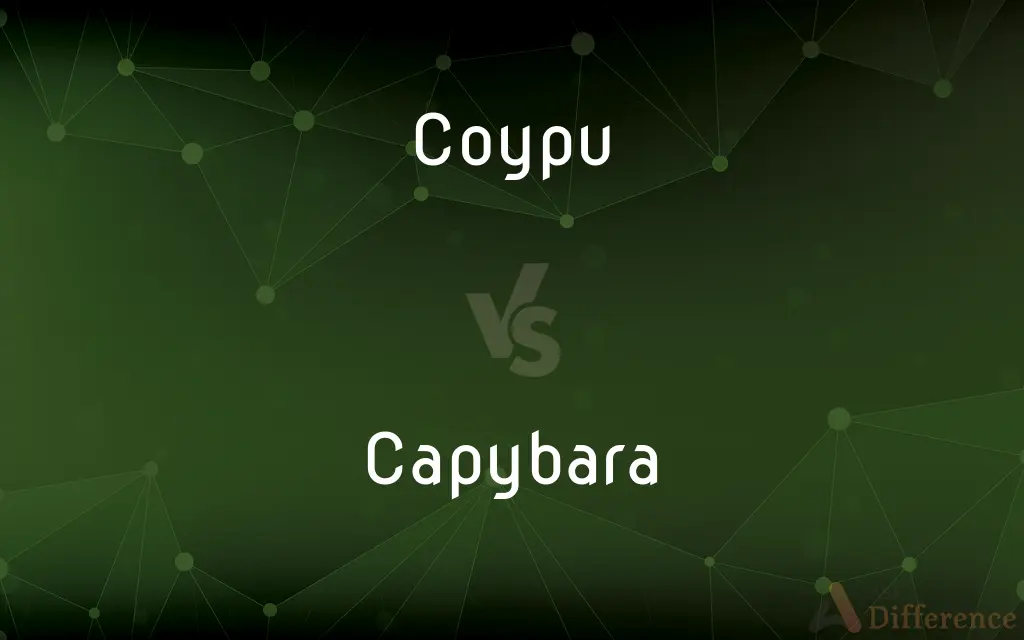Coypu vs. Capybara — What's the Difference?
By Tayyaba Rehman — Updated on January 11, 2024
Coypu (or nutria) are smaller, semi-aquatic rodents with long, rounded tails, native to South America. Capybaras are the world's largest rodents, with short, stubby tails, also native to South America.

Difference Between Coypu and Capybara
Table of Contents
ADVERTISEMENT
Key Differences
The Coypu, also known as nutria, is a smaller rodent native to South America, known for its brown, dense fur. In contrast, the Capybara, significantly larger, is the largest rodent in the world and is recognized by its bulky body and short, coarse fur.
Coypus typically weigh between 5 to 10 kg and possess long, round tails, which aid in their semi-aquatic lifestyle. Capybaras, weighing up to 75 kg, have short, stubby tails and are highly adapted to life in and around water bodies.
The habitat of the Coypu is primarily in wetlands and marshes, and their diet mainly consists of aquatic plants. Capybaras, while also favoring wetland habitats, have a more diverse diet, feeding on grasses and even tree bark.
In social behavior, Coypus are known to be more solitary or live in small family groups. Capybaras, however, are highly social and often found in large groups, exhibiting complex social structures.
Coypus have become invasive species in various parts of the world due to fur farming and accidental releases. Capybaras, although not as widespread, have gained popularity due to their docile nature and unique appearance.
ADVERTISEMENT
Comparison Chart
Size
Smaller, 5-10 kg
Larger, up to 75 kg
Tail
Long, rounded
Short, stubby
Habitat
Wetlands, marshes
Wetlands, rivers
Diet
Primarily aquatic plants
Grasses, plants, tree bark
Social Behavior
Solitary or small groups
Highly social, large groups
Compare with Definitions
Coypu
Coypu is a semi-aquatic rodent native to South America.
We spotted a coypu swimming in the marshland.
Capybara
Capybara is the world's largest rodent.
The capybara we saw at the zoo was surprisingly large.
Coypu
Coypu have long, rounded tails.
The coypu used its tail to navigate through the water.
Capybara
Capybara have short, coarse fur.
The capybara's fur felt rough and dense to the touch.
Coypu
Coypu are known for their dense, brown fur.
The coypu's fur was thick and brown, ideal for its wet habitat.
Capybara
Capybara are social animals, living in groups.
A group of capybaras was resting together by the water.
Coypu
Coypu often become invasive species.
In the new ecosystem, the coypu disrupted local wildlife balance.
Capybara
Capybara are highly adapted to aquatic environments.
We watched the capybara swim effortlessly in the lake.
Coypu
Coypu primarily feed on aquatic vegetation.
The coypu was grazing on water plants near the riverbank.
Capybara
Capybara feed on a variety of vegetation.
The capybara was munching on grass near the river's edge.
Coypu
The coypu (from Spanish coipú, from Mapudungun koypu; Myocastor coypus), also known as the nutria, is a large, herbivorous, semiaquatic rodent. Classified for a long time as the only member of the family Myocastoridae, Myocastor is now included within Echimyidae, the family of the spiny rats.
Capybara
The capybara (Hydrochoerus hydrochaeris) is a giant cavy rodent native to South America. It is the largest living rodent.
Coypu
See nutria.
Capybara
A South American mammal that resembles a giant long-legged guinea pig. It lives in groups near water and is the largest living rodent.
Coypu
A large, crepuscular, semiaquatic rodent (Myocastor coypus) resembling a large rat, having bright orange-yellow incisors, native to South America and introduced to Europe, Asia and North America, valued for its fur in eastern Europe and central Asia and considered a pest elsewhere.
Capybara
A large semiaquatic rodent (Hydrochoerus hydrochaeris) of tropical South America, having short limbs and a vestigial tail and often attaining lengths of more than 1.2 meters (4 feet).
Coypu
A South American rodent (Myopotamus coypus), allied to the beaver. It produces a valuable fur called nutria.
Capybara
A semi-aquatic South American rodent, Hydrochoerus hydrochaeris, the largest living rodent.
Coypu
Aquatic South American rodent resembling a small beaver; bred for its fur
Capybara
A large South American rodent (Hydrochærus capybara) Living on the margins of lakes and rivers. It is the largest extant rodent, being about three feet long, and half that in height. It somewhat resembles the Guinea pig, to which it is related; - called also cabiai and water hog.
Capybara
Pig-sized tailless South American amphibious rodent with partly webbed feet; largest living rodent
Common Curiosities
What do coypus eat?
Coypus primarily eat aquatic plants.
Are coypus invasive?
Yes, coypus can be invasive outside their native habitat.
What is a capybara?
A capybara is the largest rodent in the world, native to South America.
What is the social behavior of capybaras?
Capybaras are highly social and live in large groups.
How big are coypus?
Coypus weigh between 5 to 10 kg.
What is a coypu?
A coypu is a semi-aquatic rodent from South America, known for its dense fur.
Where do coypus live?
Coypus live in wetlands and marshes.
What is the size of a capybara?
Capybaras can weigh up to 75 kg.
What do capybaras eat?
They eat grasses, plants, and even tree bark.
Do capybaras have predators?
Yes, capybaras are preyed upon by jaguars, anacondas, and caimans.
Are capybaras good swimmers?
Yes, they are highly adapted to aquatic environments.
Can capybaras live in cold climates?
Capybaras prefer warm, tropical climates and may not thrive in cold environments.
Do coypus have any unique features?
Coypus are notable for their long, rounded tails and dense fur.
Can coypus be pets?
Keeping coypus as pets is not common and can be challenging.
Are coypus endangered?
Coypus are not considered endangered.
Share Your Discovery

Previous Comparison
Insight vs. Clarity
Next Comparison
Plato vs. SocratesAuthor Spotlight
Written by
Tayyaba RehmanTayyaba Rehman is a distinguished writer, currently serving as a primary contributor to askdifference.com. As a researcher in semantics and etymology, Tayyaba's passion for the complexity of languages and their distinctions has found a perfect home on the platform. Tayyaba delves into the intricacies of language, distinguishing between commonly confused words and phrases, thereby providing clarity for readers worldwide.














































